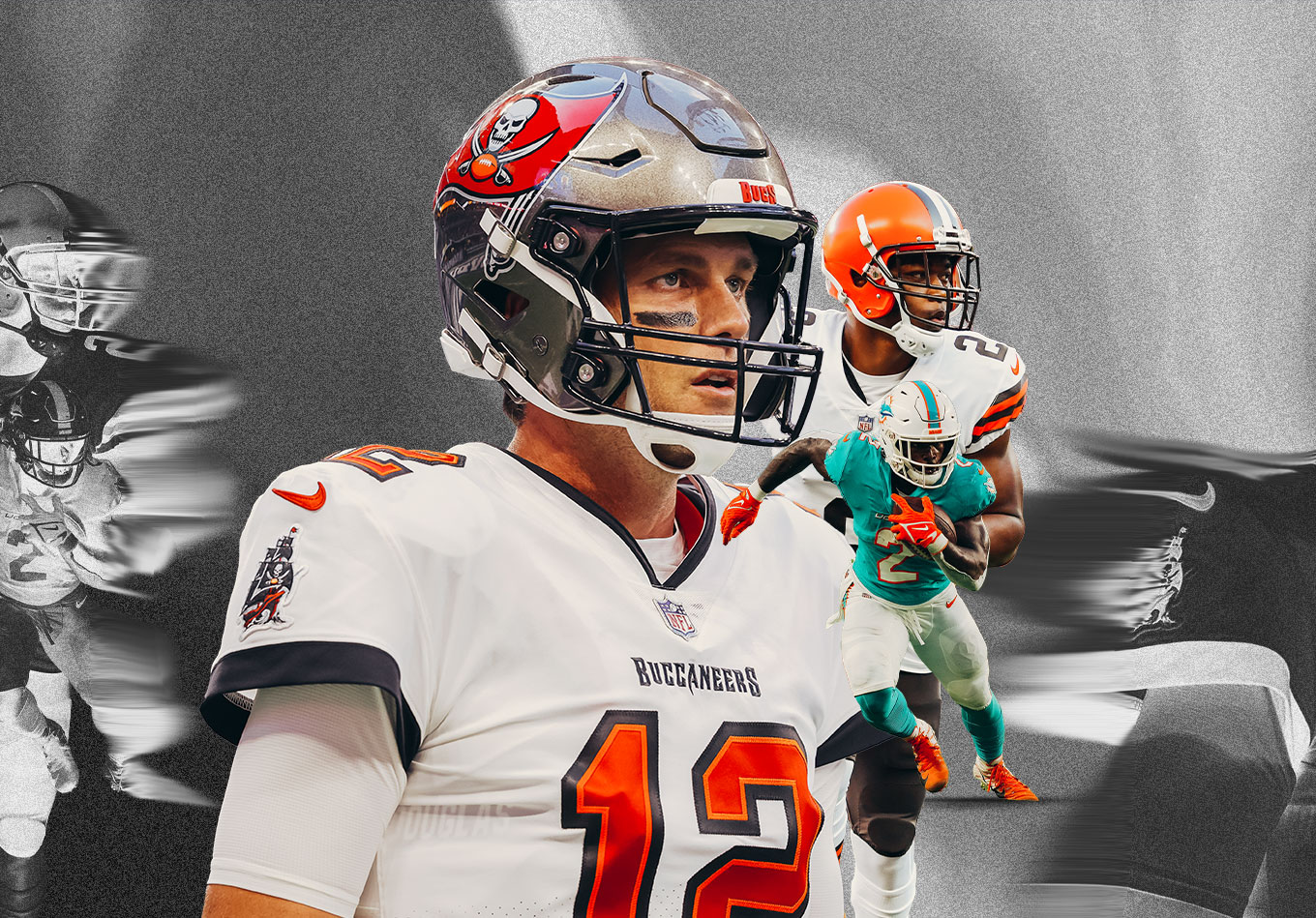Fantasy Football Quick Hits
- QB to Draft Ahead of Current ADP: Tom Brady (QB5), To Avoid at Current ADP: Joe Burrow (QB14)
- RB to Draft Ahead of Current ADP: Aaron Jones (RB7), Cordarrelle Patterson (RB20), Rashaad Penny (RB27), Chase Edmonds (RB19), To Avoid at Current ADP: Josh Jacobs (RB25), Devin Singletary (RB39)
- WR to Draft Ahead of Current ADP: Amari Cooper (WR10), Michael Thomas (WR20), Robert Woods (WR18), To Avoid at Current ADP: Tyreek Hill (WR15), DJ Moore (WR25), Terry McLaurin (WR31)
- TE to Draft Ahead of Current ADP: Robert Tonyan (TE11), To Avoid at Current ADP: Kyle Pitts (TE9)
Want More? Find our entire fantasy football rankings and projections here.
Cooper Kupp was historically good last season.
He won the receiving Triple Crown, leading the NFL in catches (145), receiving yards (1,947) and receiving touchdowns (16). In the process, he became only the second player in the last decade to produce a season scoring more than 430 fantasy points in a PPR scoring format.
In the preseason last year, we mentioned that Kupp was “the most undervalued player in all of fantasy football.” The Los Angeles Rams star’s average fantasy football draft position last season was that of a mid-to-late fifth-round pick. Our model thought he’d have a great chance at finishing a breakout season as a top-10 wide receiver.
Even though our projections were much higher than industry consensus, we obviously didn’t project him to have the greatest fantasy season by a wide receiver ever.
Why do we bring him up? Because this year Kupp is being drafted as the top wide receiver in fantasy football. He’s also the No. 1 wide receiver in our projections, which makes him properly valued. You won’t find Kupp on this list. Instead, we are going to highlight players our model indicates will either outperform or underperform their industry-wide ADPs.
Note: The ADPs (average draft position) for these players are coming from the consensus fantasy football rankings at Fantasy Pros as of Aug. 31. For our purposes, we will be assuming a full PPR (one point per reception) league format.
QB to Draft Ahead of Current ADP
Tom Brady, Tampa Bay Buccaneers (ADP: 87, Our Rank: QB5)
Let’s start with the old guy (sorry, Tom) guiding the Buccaneers. Brady is entering his 23rd NFL season and the only reason he’s being drafted so late (QB9) is because his career has been going on for so long. He’s actually been playing in the NFL longer than the Houston Texans franchise.
Because, from a football perspective Brady, impossibly, seems to be getting better. Here are just a few of the stats Brady led the NFL in last season: completions (485), passing yards (5,316), passing touchdowns (43) and pass plays of 25 yards or more (42).
Rushing quarterbacks are all the rage in fantasy these days but nothing beats volume. Brady, who has finished in the top two in passing attempts in each of his two seasons in Tampa Bay, will have plenty of that to be in contention for a top-five finish.
He’s behind only Josh Allen of the Buffalo Bills, Patrick Mahomes of the Kansas City Chiefs, Jalen Hurts of the Philadelphia Eagles and Aaron Rodgers of the Green Bay Packers in our projections, but ahead of Lamar Jackson of Baltimore Ravens, Kyler Murray of the Arizona Cardinals, Dak Prescott of the Dallas Cowboys and Rams signal-caller Matthew Stafford.
Our model projects him to end the season with the most passing attempts and the second-most passing yards. Don’t let age be the only reason you don’t take the player whose peers just voted him as the No. 1 player in football for this upcoming season.
QB to Avoid at Current ADP
Joe Burrow, Cincinnati Bengals (ADP: 58, Our Rank: QB14)
There are reasons to love Joe Burrow, the football player. The Bengals quarterback is a strong, tough, leader with a host of dynamic weapons surrounding him, including last year’s offensive rookie of the year Ja’Marr Chase and Tee Higgins.
Burrow led the NFL in well-thrown percentage as his Bengals made a surprise run to the Super Bowl.
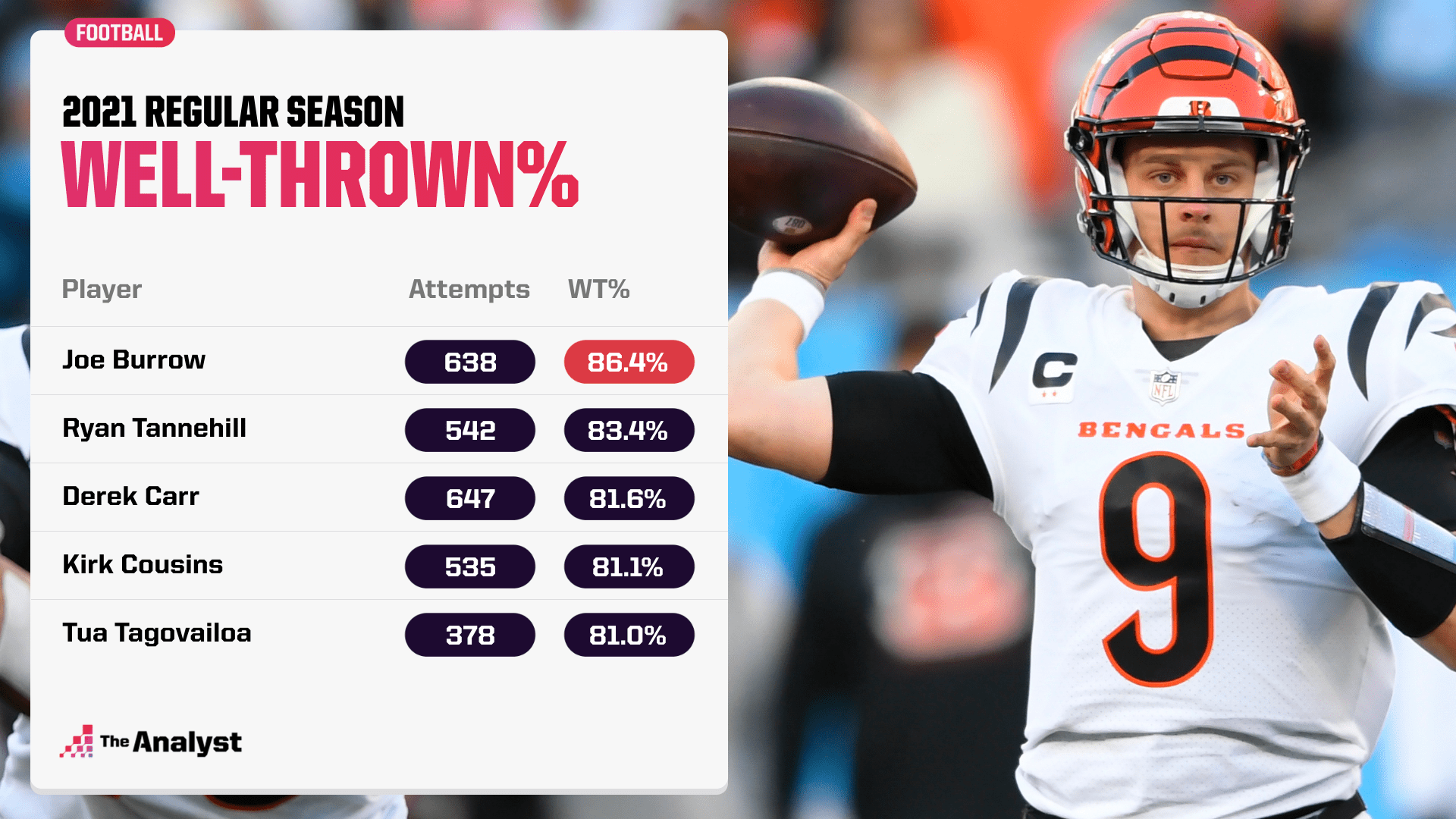
But from a fantasy perspective, there are reasons to be pessimistic. For starters, Burrow was 15th in pass attempts last season, and he only had one game with more than 40 passing attempts. For comparison, Brady had 10 such games last season and Dak Prescott, another QB going much later than Burrow, had four. Burrow finished 10th in fantasy points per game last season, and even that number was significantly boosted by his final two games in which he threw for a combined 971 yards and eight touchdowns.
Burrow is our QB14 entering the season with Justin Herbert of the Los Angeles Chargers, Derek Carr of the Las Vegas Raiders, Russell Wilson of the Denver Broncos and Kirk Cousins of the Minnesota Vikings among those ranked ahead of him. Carr, our model’s QB11, has an ADP currently of 110, 54 spots later than Burrow.
The smart play is to pass on Burrow and wait for the ninth or 10th round to grab your quarterback.
RBs to Draft Ahead of Current ADP
Aaron Jones, Green Bay Packers (ADP: 21, Our Rank: RB7)
Davante Adams had 169 targets last season. He is now on the Las Vegas Raiders. The player with the second-most receptions on the Packers last season? You guessed it, Jones, with 52. In eight of his 15 games played last season, Jones had at least four receptions. Those vacant Adams’ targets need to go to someone, and Jones, who has the trust of Aaron Rodgers, is a good bet to receive a chunk of them.
Sure, he has AJ Dillon to contend with, but Jones’ demise in the running game is overstated and pass-catching opportunities are more valuable than rushes.
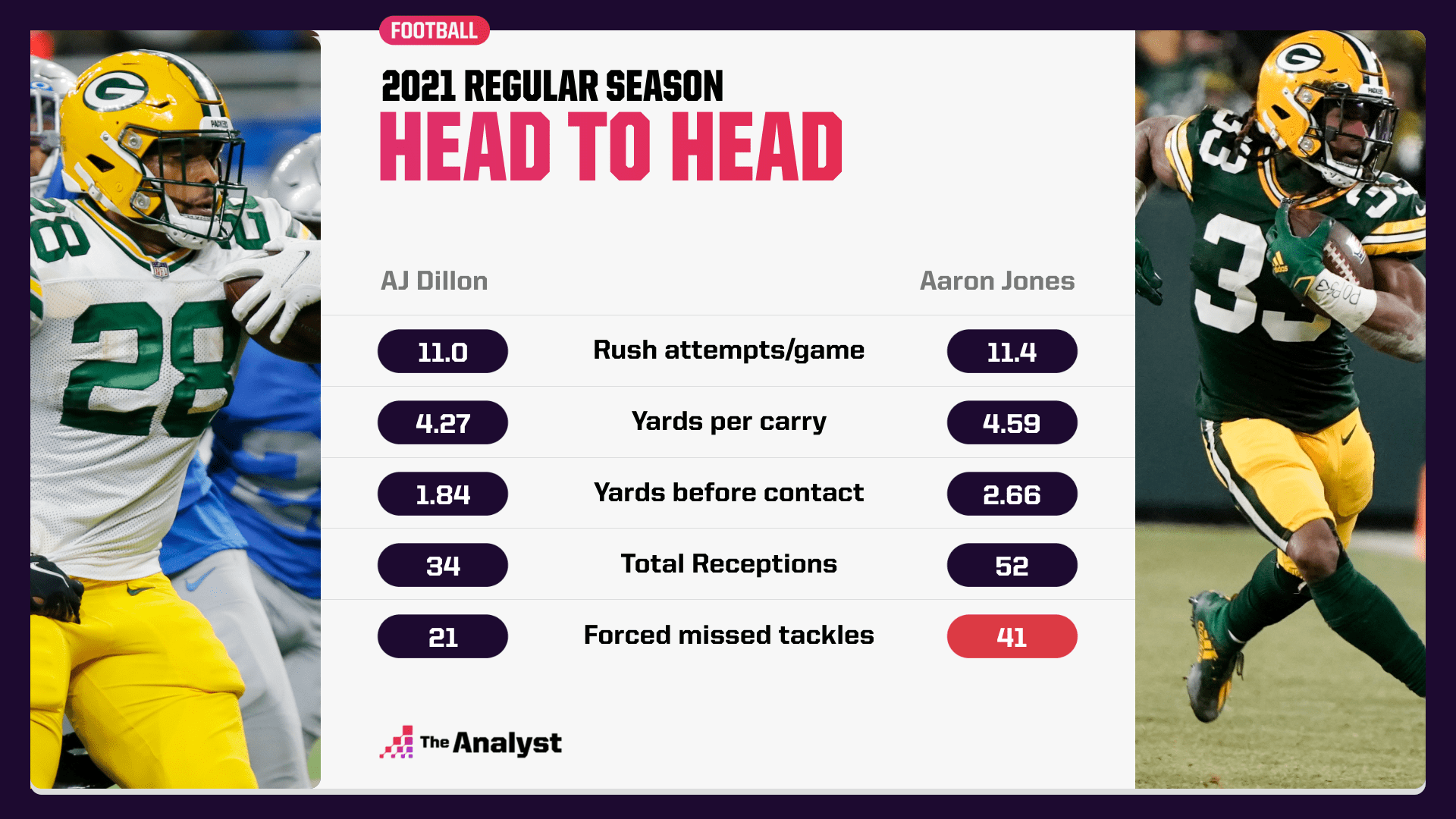
Jones had at least 80 scrimmage yards or a touchdown in 11 games last season. His 61 projected receptions are second most among all running backs. This guy is currently being drafted as RB14, in the late second- to early third-round portion of fantasy drafts. He’s ahead of Najee Harris of the Pittsburgh Steelers (RB8) and Alvin Kamara of the New Orleans Saints (RB9) and just behind Joe Mixon of the Bengals in our rankings.
We’re projecting there will be seven elite running backs this season. Jones is a part of that group.
Cordarrelle Patterson, Atlanta Falcons (ADP: 78, Our Rank: RB20)
Are people forgetting what they saw last season? Sure, the Falcons weren’t very good and Matt Ryan is now with the Indianapolis Colts but Patterson, in his first year as a true running back, finished the season as RB9. Leading us to this season, where Patterson is being drafted…in the seventh or eighth round as the 28th running back off the board?
In his transition to the running back position, he didn’t suddenly forget how to catch the ball in the offseason. In fact, it was his biggest strength. Amongst running backs, he finished second in receiving yards and third in receiving touchdowns.
And oh, by the way, the Falcons let the player (Mike Davis) with the second-most rush attempts on their roster last season leave and replaced him with a back who has 40 rushing attempts combined the last two seasons.
Patterson has already proven he can be a low-end RB1. He’s being drafted like an RB3.
Rashaad Penny, Seattle Seahawks (ADP: 86, Our Rank: RB27)
Jonathan Taylor scored 91 fantasy points in his final five games last season. Austin Ekeler scored 99.1 points in his final five games on his charge to an RB2 yearly finish. Penny scored 110.2. He was the best fantasy back for the final third of the season, and he is currently being drafted in the eighth round in 12-team leagues as the 31st running back off the board.
His biggest risk is health. Penny led the NFL in yards per carry last season (6.29) and his career average of 5.6 yards per rush is higher than Derrick Henry has managed in any of his six seasons in the NFL. If he can just stay on the field, you’re looking at drafting a player who has proven he can carry RB1 value in the later rounds of your draft.
Even considering his penchant for getting hurt, resulting in his baseline projection accounting for more missed snaps than average among running backs, Penny is our RB27 for the season. You’re not drafting him to be the star of your fantasy team, but as your RB3, he’s a steal.
Chase Edmonds, Miami Dolphins (ADP: 92, Our Rank: RB19)
Unlike Patterson, Edmonds’ ADP makes sense. He finished last season as RB34, and this year, he’s being drafted in the 90s as the 34th running back. So why then, do we have him as a top-20 running back?
Well, last season, Edmonds was teammates with one James Conner who, let’s just say, scored a lot of touchdowns. Edmonds finished the year with a measly two touchdowns. But he averaged 5.1 yards per carry to Conner’s 3.7, and he had 43 receptions to Conner’s 37.
This year, on a team where he can reasonably expect more touches in the red zone, Edmonds is due for a little touchdown regression to the mean, in a good way. With former Shanahan disciple Mike McDaniel at the helm in Miami, the run game should be creative and productive. He’s just behind some big-name backs like Ezekiel Elliott of the Cowboys (RB15) and Nick Chubb (RB17) of the Cleveland Browns in our rankings.
Combined with his pass catching abilities, Edmonds is a great bet to finish the year significantly ahead of his ADP.
RBs to Avoid at Current ADP
Josh Jacobs, Las Vegas Raiders (ADP: 47, Our Rank: RB25)
There’s a lot of skepticism surrounding Jacobs’ fantasy prospects, so let’s start with why he’s so highly rated in the first place. In each of the last two seasons, Jacobs has finished as a top-12 PPR running back. If fantasy managers had confidence that he could replicate that type of finish for a third straight season, he’d be going 20 spots higher.
Unfortunately, for the fourth year running back out of Alabama, his chances of doing that are slim. In fact, our model is so skeptical that Jacobs falls on our list of players to avoid. Why? Because most of Jacobs’ value in the past two years has come from his massive workload.
Jacobs only had three games with more than 110 scrimmage yards last season, and in those three games he averaged 26.7 touches per game. In the other 12 games he played, he never once recorded 100 scrimmage yards. And in those 12 contests, he still averaged a solid 15.9 touches per game.
Meanwhile, new coach Josh McDaniels comes to town after spearheading a New England Patriots offense that has historically been an offense that employs the strategy of running back by committee. Despite our projections being bullish on Jacobs’ chances of recording 1,000 rushing yards, the additions of rookie Zamir White and especially pass-catching specialist Ameer Abdullah will likely eat into Jacobs pass-catching volume, resulting in a precipitous drop in our rankings.
He’s outside of our model’s top-20 running backs.
Devin Singletary, Buffalo Bills (ADP: 81, Our Rank: RB39)
If you know that Singletary is going to be the lead back on the Bills, draft him! Trouble is, between Zack Moss and second-round draft pick James Cook, and a gun-slinging quarterback that is a dynamite red-zone runner, predicting any volume of significance for Singletary is troublesome.
To that end, Singletary comes in as our RB39. In other words, we’re predicting a bunch of second-string running backs in more favorable situations (think teams like New England and Green Bay) to be more productive than Singletary. Only the Chiefs first running back (Jerick McKinnon, seen by some as a sneaky sleeper) is lower in our projections than Singletary.
At his ADP, he’s currently being selected before running backs like Penny and Tony Pollard, which is a major stretch. If you’re drafting Singletary, you’re just hoping that Cook doesn’t take too many of the valuable passing opportunities, Josh Allen doesn’t take too many of the rushing touchdowns, and Moss remains a distant third in the pecking order.
That’s a lot of ifs.
WRs to Draft Ahead of Current ADP
Amari Cooper, Cleveland Browns (ADP: 64, Our Rank: WR10)
There are lots of reasons to be concerned about Cooper. He plays for a run-first team, his quarterback for the first 11 games is unproven, and he’s moving from playing his home games indoors to playing them outdoors. You may ask, does that really matter? It does. In his career, Cooper averages 5.5 receptions, 81.1 receiving yards and 0.5 touchdowns per game indoors vs 4.4 receptions, 57.7 receiving yards and 0.4 touchdowns per game outdoors.
That is a drastic difference of almost 4.5 fantasy points per game.
However, now that we’ve got the bad out of the way, there’s plenty of good. For starters, he’s the only Browns wide receiver projected to finish in the top 40 and the only receiver on the Browns our model expects to receive more than 100 targets. Despite being overshadowed by CeeDee Lamb for chunks of last season, Cooper was highly productive without seeing a ton of volume. His burn percentage of 69.6 was the fourth highest in the NFL.
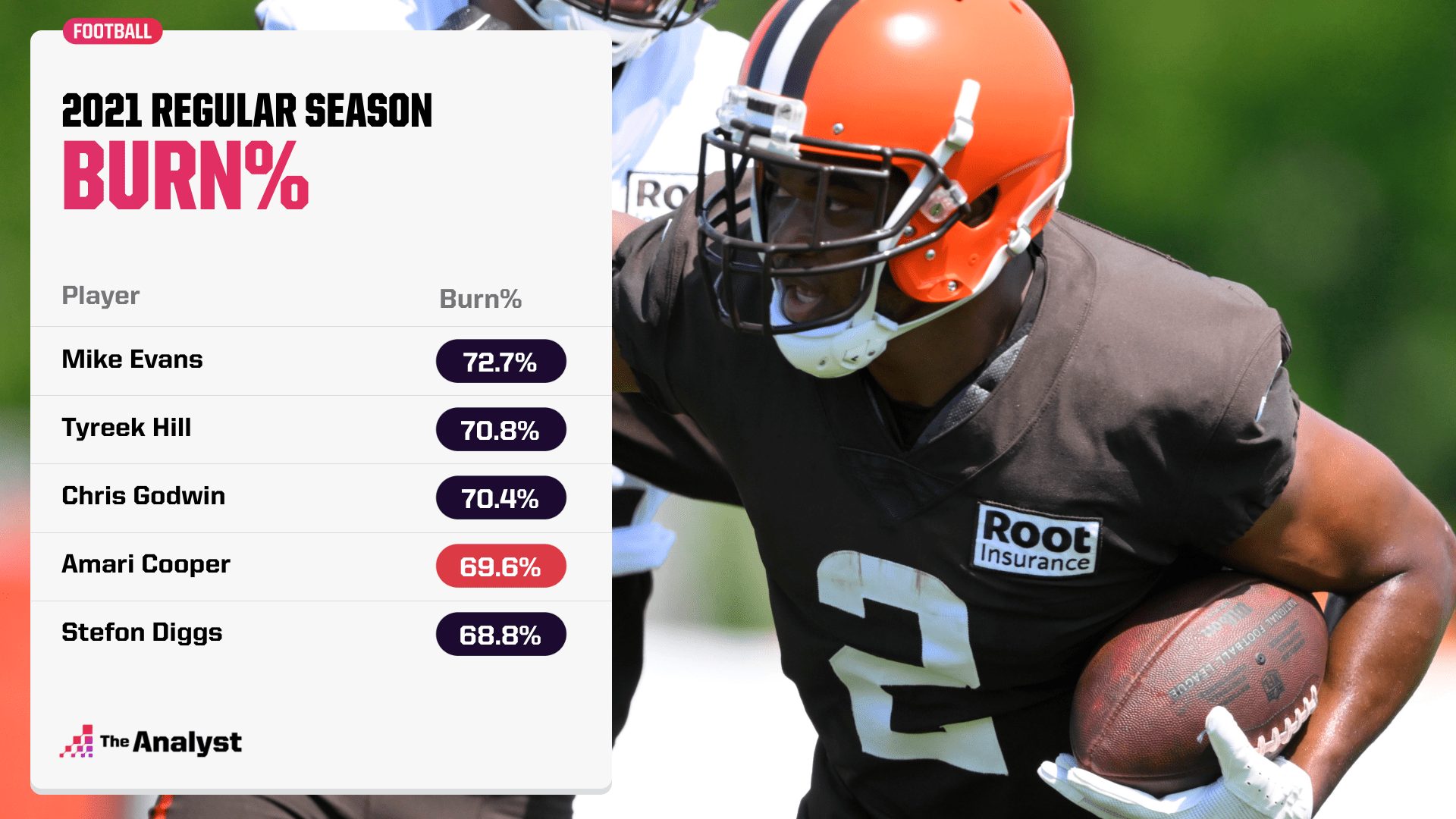
But most importantly, he’s currently being drafted as the 26th wide receiver. The worries surrounding Cooper have been more than baked into his low ADP. He’s finished as top-15 receiver twice in the last four years and has averaged a finish of WR18 during that time.
Our model is bullish on his chances of besting that mark this season. If you don’t get one of that top group that includes Kupp, Adams, Justin Jefferson and Stefon Diggs, Cooper isn’t a bad consolation prize as our WR10.
Michael Thomas, New Orleans Saints (ADP: 80, Our Rank: WR20)
If you’re new to fantasy football and asking, “who?” well, we don’t blame you! Thomas has only played seven games in the last two and a half years. So, allow us to reintroduce you to Michael Thomas.
A star coming out of Ohio State, Thomas took the NFL world by storm, recording 92 receptions in his rookie season. He delivered three straight 100-reception seasons after that, culminating in his historic 2019 season when he set the all-time catches mark in a single season with 149.
For his career, Thomas averages 7.3 receptions and 85 receiving yards per game. In case you’re wondering, the great Calvin Johnson averaged 5.4 receptions and 86.1 receiving yards per game and Jerry Rice, perhaps the greatest receiver of all time, had career averages of 5.1 receptions and 75.6 receiving yards. These comparisons are all just a fancy way of saying this guy is really, really good.
He’s also really injury prone, hence his low ADP. Even accounting for that, Thomas is still a smart investment. If we projected him to play the same percentage of passing snaps as the average wide receiver, Thomas would be a top 10 WR. Instead, our model is producing Thomas’ numbers as if he is going to play significantly less than average, which is why he comes in as our WR20 instead.
Basically, if you can grab this guy in the seventh round, you’ll be selecting a player whose best-case scenario is a lot better than almost every other wide receiver in the NFL.
Robert Woods, Tennessee Titans (ADP: 100, Our Rank: WR18)
A.J. Brown is now in Philadelphia. Julio Jones is in Tampa Bay and Anthony Firkser is currently a free agent. We just listed three of the four reception leaders for Ryan Tannehill and the Titans from a season ago. Someone’s going to have to catch some passes. Enter Bobby Trees.
Woods, in his last three healthy seasons, has finished as a top-15 wide receiver all three seasons. Buoyed by his consistency, he averaged 88.7 receptions during those three seasons. Yes, Woods now plays on a Titans team that led the NFL in run plays a season ago (551), but that’s baked into his projection of 74.9 receptions.
Treylon Burks is the sexy pick. He’s currently being selected just 17 picks after Woods. But Woods is the proven commodity, and as the 42nd wide receiver off the board, he’s a steal. He won’t win you your league, but he’ll be someone you are confident starting while your stars are on their byes.
Note: The Buffalo Bills defense has a higher ADP (97th) than Woods. Please don’t be that person. Defenses and kickers should be your last two picks, period.
WRs to Avoid at Current ADP
Tyreek Hill, Miami Dolphins (ADP: 20, Our Rank: WR15)
Let’s take this opportunity to remind folks that just because we’re down on someone doesn’t mean you shouldn’t draft them. If Hill and Thomas are both available for you to draft in Round 3, go ahead and take Hill. They’re both great players, but Hill is more of a sure thing, and you will almost certainly be able to draft Thomas in a later round.
With that caveat out of the way, Hill is undeniably the most transcendentally good player to be on our list of players to be wary of. And he’s here for two main reasons. The first is his previous quarterback was a lad named Patrick Mahomes and in case you haven’t heard of him, he’s pretty good. They are no longer on the same team, so those spectacular numbers he’s put up since Mahomes became the quarterback are almost certainly going to go down.
The second reason Hill is here is because he’s now playing on a team whose quarterback is decidedly not Mahomes. Tua Tagovailoa has his good qualities – including being the most accurate quarterback in the NFL, well, according to Hill at least – but, if you close your eyes and think about the Mahomes-Hill connection, you’re almost certainly thinking about Mahomes running around and finding Hill 20+ yards downfield for a big connection.
Case in point, Mahomes led all quarterbacks last season in attempting 66 passes of 10 or more air yards while on the move. Tagovailoa only attempted 13 such passes.
Without the big plays, Hill becomes a little more boom/bust as opposed to being consistently elite while also producing huge performances. In addition, he’ll be fighting with Jaylen Waddle for targets. Our model is expecting a large drop in Hill’s stats. He’s outside of our top-12 wide receivers for this season.
DJ Moore, Carolina Panthers (ADP: 43, Our Rank: WR25)
Like Hill, Moore is here for one main reason. Baker Mayfield is now his quarterback, and he might just be better at acting than he is at playing the quarterback position. Mayfield only threw 17 touchdown passes in 14 games last season to go along with 13 interceptions. And the Browns leading wide receiver ended with 570 receiving yards.
Unlike Hill, Moore also has one other large factor to contend with. Christian McCaffrey is back, and one way to limit your quarterback’s involvement is to draw up lots of screen plays and dump-offs, which just happen to be McCaffrey’s specialty. In fact, our model is projecting McCaffrey to end the season with more receptions than Moore.
It’s really too bad because Moore is an excellent player. The list of players with more burns than Moore last season reads like the who’s who at the position (Kupp, Hill, Diggs, Adams, Jefferson, Chase, Allen). He’s even produced gaudy counting numbers despite subpar quarterback play throughout his career, with three straight years recording at least 1,100 receiving yards. But with so many risks involved, drafting him before or during the fifth round is a risky proposition.
Terry McLaurin, Washington Commanders (ADP: 39, Our Rank: WR31)
Sensing a pattern across our model’s least favorite wide receivers? Can I have elite receivers on bad teams with bad quarterbacks for 200 please?
McLaurin rounds out our list and like Moore, he’s been extremely productive despite poor quarterback play, recording over 1,000 receiving yards in the last two seasons. He’s done this despite showcasing an inability to get open. McLaurin’s open percentage of 62.3 last season was the third lowest amongst all receivers with 50 or more receptions.
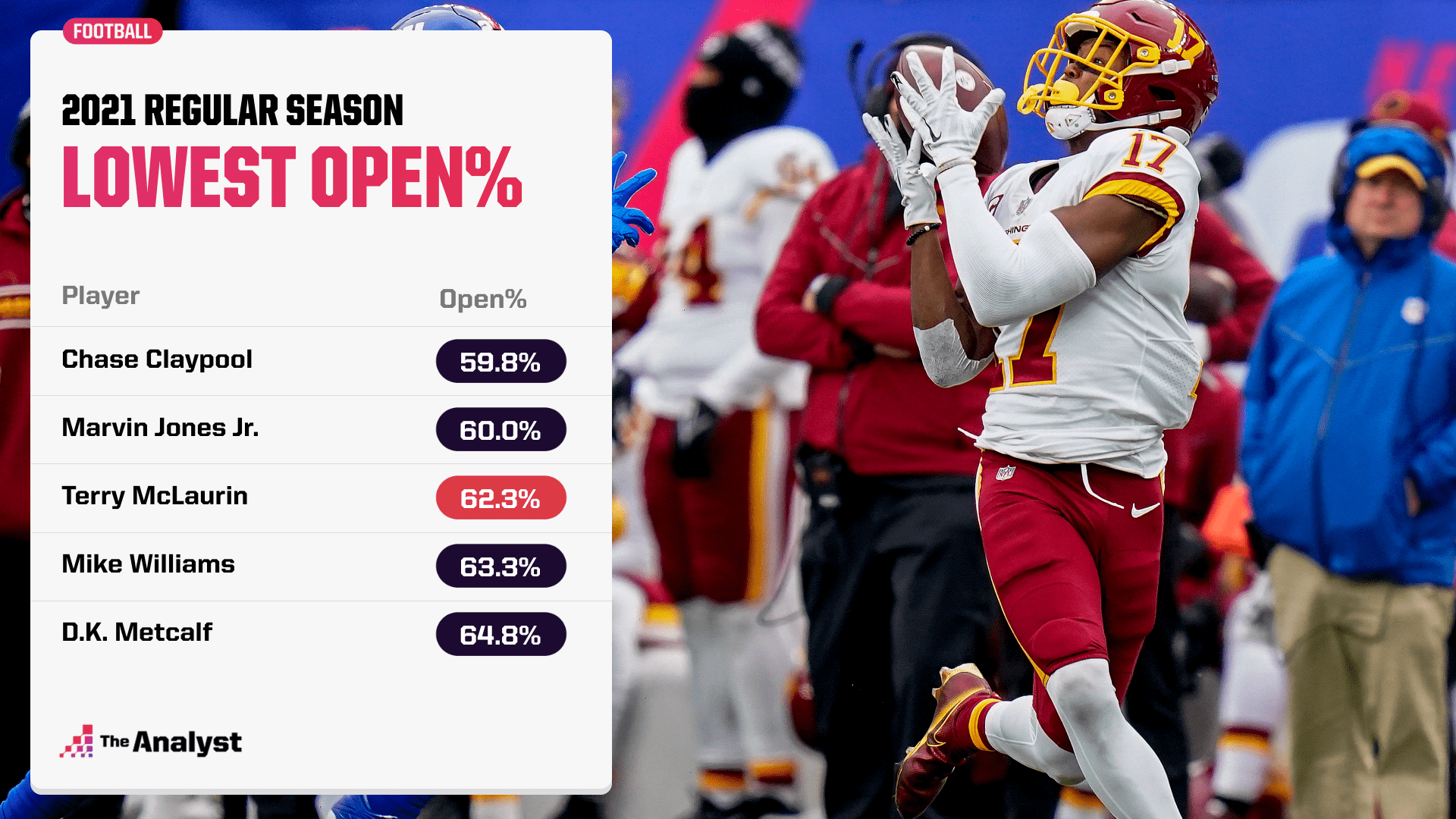
Paired with Carson Wentz’s 74.6 well-thrown percentage that was significantly below league average (78.1%), McLaurin might struggle to have the same production as he’s previously shown in his career in those tight areas and contested catch situations.
Our model is certainly skeptical. He is the lowest of the three receivers we’ve listed to avoid, projected on average to produce numbers closer to that of a low-end WR2.
Certainly nowhere near what he’s being drafted to be.
TE to Draft Ahead of Current ADP
Robert Tonyan, Green Bay Packers (ADP: 172, Our Rank: TE11)
If fantasy managers choose to employ a strategy of waiting until the later rounds to select a tight end, Tonyan might be the best positioned of the bunch to potentially produce like a top-10 tight end.
The strength of Tonyan’s case lies almost exclusively in his ability to score touchdowns, as evidenced by his 11-touchdown season in 2020. He’s got the fourth-most projected touchdowns amongst tight ends, boosting him to comfortably inside our top 10 because if you’re not Travis Kelce or Mark Andrews, touchdowns are more valuable than gold.
TE to Avoid at Current ADP
Kyle Pitts, Atlanta Falcons (ADP: 32, Our Rank: TE9)
There may be no one more universally loved in fantasy corners than Pitts, making this our model’s most aggressive call. The knock on Pitts is what we just discussed with Tonyan – touchdowns. His 2.2 projected touchdowns are 34th (!!!) amongst all tight ends, despite being projected to produce receiving numbers relatively similar to that of George Kittle. As a result, Pitts finds himself lower in our model’s eyes than the industry consensus.
And before you brush this off, shrug your shoulders, and say he’s for sure going to score more than two touchdowns, consider that he only scored once last season. And that his new quarterback is Marcus Mariota, who’s only thrown 31 touchdown passes in his last 34 starts.
Of course, you can digest all those risks and decide to draft him anyway. He’s a big fantasy nay for us in comparison to ADP.
Enjoy this? Subscribe to our newsletter to receive five stories each Friday. It’s free
